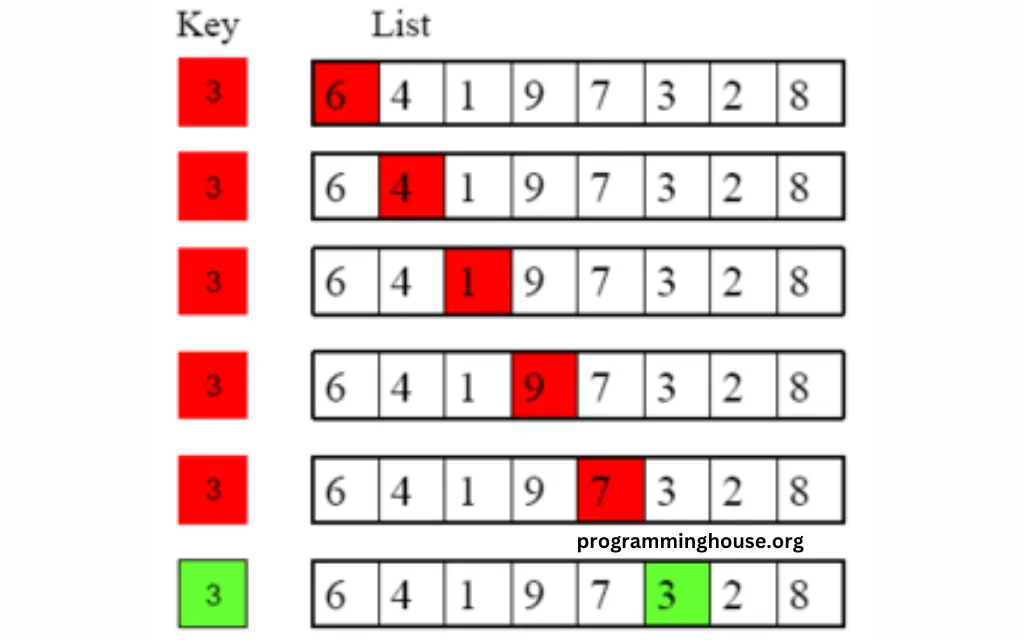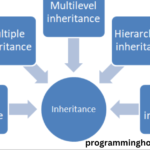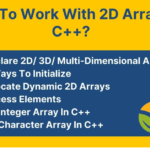Introduction of Searching in Arrays
Arrays are one of the most fundamental data structures in computer science and programming. They are used to store multiple elements in a single variable, making them ideal for managing collections of data. Searching through an array to find specific elements is a common task, and there are various algorithms designed to perform this search efficiently. This article provides a detailed overview of searching in arrays, discussing different types of search algorithms, their use cases, and their efficiency.

What is an Array?
An array is a data structure that consists of a collection of elements, each identified by an index or a key. Arrays can store elements of a single data type (such as integers, floats, or strings) and are typically used when you need to store and access data sequentially. Arrays are popular due to their simplicity and the ability to access elements in constant time using their index.
Types of Arrays
- One-dimensional arrays: These are the simplest type, with elements stored in a single row.
- Multi-dimensional arrays: These arrays have more than one dimension, such as two-dimensional arrays (matrices) where data is stored in rows and columns.
Why Search in Arrays?
Searching in arrays is a fundamental operation that is performed to find whether a specific element exists in the array and, if so, to determine its position. Searching is crucial in various applications, such as database queries, data processing, and in implementing algorithms that require frequent data retrieval.
Types of Search Algorithms
There are several search algorithms, each with its advantages of arrays and disadvantages depending on the array’s structure and the specific requirements. The most common search algorithms include:
- Linear Search
- Binary Search
- Jump Search
- Interpolation Search
- Exponential Search
- Fibonacci Search
Let’s explore each of these in detail.
1. Linear Search
Linear Search is the simplest and easy search algorithm. In this method, each element of the array is checked sequentially until the desired element is found or the array ends.
How Linear Search Works:
- Start from the first element and compare it with the target value.
- If the element found the target, return the index.
- If it doesn’t match, move to the next element.
- Continue this process until the element is found or the array ends.
Example:
def linear_search(arr, x):
for i in range(len(arr)):
if arr[i] == x:
return i
return -1Use Case:
Linear search is most effective for small arrays or when the data is unsorted. It is also useful when the cost of sorting an array outweighs the benefits of faster search times.
Time Complexity:
- Best Case: O(1) (when the element is the 1 element)
- Worst Case: O(n) (when the target element is at the end or not present)
- Average Case: O(n)
2. Binary Search
Binary Search is a much more efficient algorithm than linear search, but it requires the array to be sorted. This algorithm works by repeatedly dividing the array in half and comparing the middle element with the target value.
How Binary Search Works:
- Begin by comparing the middle element of the array with the target value.
- If the target found at the middle element, return the index.
- If the target is less than the middle element, search the left half of the array.
- If the target is < than the middle element, search the right half.
- Repeat this process until the element is found or the subarray reduces to zero.
Example:
def binary_search(arr, x):
low = 0
high = len(arr) - 1
while low <= high:
mid = (low + high) // 2
if arr[mid] == x:
return mid
elif arr[mid] < x:
low = mid + 1
else:
high = mid - 1
return -1Use Case:
Binary search is ideal for large datasets that are already sorted. It significantly reduces the number of comparisons needed to find an element.
Time Complexity:
- Best Case: O(1) (when the middle element is the target)
- Worst Case: O(log n)
- Average Case: O(log n)
3. Jump Search
Jump Search is an algorithm use for searching in sorted arrays. It works by dividing the array into blocks of a fixed size and then searching within these blocks.
How Jump Search Works:
Jump Search is an treasure use for probing in arranged arrays. It everything by separating the array into blocks of a established diameter and therefore probing inside these blocks.
How Jump Search Works:
- Determine the optimum block capacity to jump (generally √n).
- Start at the first block and equate the last aspect of the block accompanying the aim.
- If the factor is better, act a uninterrupted search inside the block.
- If not, jump to the next block and repeat the process.
Example:
import math
def jump_search(arr, x):
n = len(arr)
step = math.sqrt(n)
prev = 0
while arr[int(min(step, n)-1)] < x:
prev = step
step += math.sqrt(n)
if prev >= n:
return -1
for i in range(int(prev), int(min(step, n))):
if arr[i] == x:
return i
return -1Use Case:
Jump search is beneficial for large sorted arrays where binary search might not be as efficient due to its recursive nature.
Time Complexity:
- Best Case: O(√n)
- Worst Case: O(√n)
- Average Case: O(√n)
4. Interpolation Search
Interpolation Search is another search invention for sorted arrays. It advances on twofold search by judging the position of the goal profit established the principles of the items.
How Interpolation Search Works:
The position of the mark is supposed utilizing a rule that adopts the ingredients are consistently delivered.
- Compare the supposed position accompanying the goal.
- If it competitions, return the index.
- If the aim is tinier, search the abandoned subarray.
- If the mark is best, search the right subarray.
- Repeat the process as far as the component is establish or the subarray is shortened to nothing.
Example:
def interpolation_search(arr, x):
low = 0
high = len(arr) - 1
while low <= high and x >= arr[low] and x <= arr[high]:
pos = low + int(((float(high - low) / (arr[high] - arr[low])) * (x - arr[low])))
if arr[pos] == x:
return pos
if arr[pos] < x:
low = pos + 1
else:
high = pos - 1
return -1Use Case:
Interpolation search works best with uniformly distributed data and large sorted arrays.
Time Complexity:
- Best Case: O(1)
- Worst Case: O(n)
- Average Case: O(log log n)
5. Exponential Search
Exponential Search is an algorithm that is particularly useful when the target is closer to the beginning of the array. It combines binary search with an exponential increase in the range to search for the target.
How Exponential Search Works:
- Start by checking the first element.
- If it matches the target, return the index.
- If not, keep doubling the range until the target is smaller than the last element of the range.
Example:
def binary_search(arr, x, low, high):
while low <= high:
mid = (low + high) // 2
if arr[mid] == x:
return mid
elif arr[mid] < x:
low = mid + 1
else:
high = mid - 1
return -1
def exponential_search(arr, x):
if arr[0] == x:
return 0
i = 1
while i < len(arr) and arr[i] <= x:
i *= 2
return binary_search(arr, x, i // 2, min(i, len(arr)-1))Use Case:
Exponential search is useful in scenarios where the target element is expected to be located near the beginning of a large sorted array.
Time Complexity:
- Best Case: O(1)
- Worst Case: O(log n)
- Average Case: O(log n)
6. Fibonacci Search
Fibonacci Search is similar to binary search but uses Fibonacci numbers to divide the array into smaller sections. This method is beneficial in certain situations where the comparison cost is high.
How Fibonacci Search Works:
- Generate the smallest Fibonacci number greater than or equal to the length of the array.
- Use the Fibonacci number to divide the array into sections and compare the target with the elements at these Fibonacci indices.
- Based on the comparison, narrow down the section to search further.
- Repeat the process until the element is found or the section is reduced to zero.
Example:
def fibonacci_search(arr, x):
n = len(arr)
fibMMm2 = 0
fibMMm1 = 1
fibM = fibMMm2 + fibMMm1
while (fibM < n):
fibMMm2 = fibMMm1
fibMMm1 = fibM
fibM = fibMMm2 + fibMMm1
offset = -1
while (fibM >
1):
i = min(offset+fibMMm2, n-1)
if (arr[i] < x):
fibM = fibMMm1
fibMMm1 = fibMMm2
fibMMm2 = fibM - fibMMm1
offset = i
elif (arr[i] > x):
fibM = fibMMm2
fibMMm1 = fibMMm1 - fibMMm2
fibMMm2 = fibM - fibMMm1
else:
return i
if(fibMMm1 and arr[offset+1] == x):
return offset+1
return -1Use Case:
Fibonacci search is best suited for large sorted arrays, especially in scenarios where the cost of comparison is higher than the cost of calculation.
Time Complexity:
- Best Case: O(1)
- Worst Case: O(log n)
- Average Case: O(log n)
Comparing Search Algorithms
When choosing a search algorithm, it’s essential to consider the nature of the array and the efficiency of the algorithm. Here’s a quick comparison:
| Algorithm | Best Case Time Complexity | Worst Case Time Complexity | Use Case |
|---|---|---|---|
| Linear Search | O(1) | O(n) | Small or unsorted arrays |
| Binary Search | O(1) | O(log n) | Large, sorted arrays |
| Jump Search | O(√n) | O(√n) | Large, sorted arrays |
| Interpolation Search | O(1) | O(n) | Uniformly distributed, sorted arrays |
| Exponential Search | O(1) | O(log n) | Large sorted arrays with expected early match |
| Fibonacci Search | O(1) | O(log n) | Large, sorted arrays with high comparison cost |
Conclusion
Searching in arrays is a fundamental movement that all especially a hobbyist endure comprehend. The choice of a search treasure depends on the diameter of the array, either the array is categorized, and the classification of the materials inside the array. Linear search is plain but wasteful for big arrays, while twofold search offers a meaningful speed-up but demands the array expected categorized. Other algorithms like jump search, introduction search, rapid change search, and Fibonacci search offer specific answers for various synopsises.
Understanding these algorithms and their use cases will authorize you to pick the right approach for your distinguishing question, guaranteeing that your programs are two together effective and productive.



